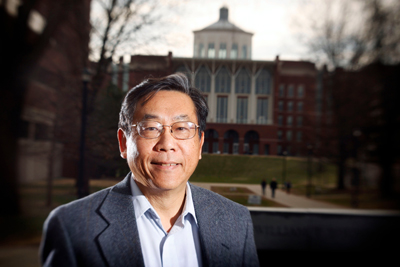by Robin Roenker
photos by Mark Cornelison
As a theoretical physicist, Keh-Fei Liu’s computational simulations in the field of quantum chromodynamics can simultaneously shed light on the innermost workings of the smallest particles in our universe, as well as help better understand how the universe itself came into being.
Quantum chromodynamics (QCD) is the study of the strong force between quarks and gluons, which combine to form hadrons, such as protons, neutrons, and pions.
For the past 15 years, Liu has led an international team of QCD collaborators—including faculty at George Washington University, the University of Virginia, the University of Washington, India’s TIFAR Institute, and the Chinese Institute of High Energy Physics—in working to answer a key question about the structure of the proton. Namely, what is the source of its spin?
Physicists first thought that the proton’s ½ spin was the result of the spins of its three quarks. When that proved untrue, other suggestions were both computationally and experimentally tested, including that the “spin crisis” was the result of the strong interaction between the proton’s quarks and gluons.
 "The experimental and theoretical efforts of the past 20 years or so has been to try to find out how much of the proton spin is comprised by the quarks, how much is by the gluons, how much is the orbital angular momentum, and so on,” explained Liu, who joined UK’s Physics Department in 1980. “But, experimentally, that is very uncertain. And there is no model that can describe that. So our job is to use the large computer simulations to find out, theoretically, each component of the proton spin.”
"The experimental and theoretical efforts of the past 20 years or so has been to try to find out how much of the proton spin is comprised by the quarks, how much is by the gluons, how much is the orbital angular momentum, and so on,” explained Liu, who joined UK’s Physics Department in 1980. “But, experimentally, that is very uncertain. And there is no model that can describe that. So our job is to use the large computer simulations to find out, theoretically, each component of the proton spin.”
Drawing on 30-40 million core hours of advanced computer simulations conducted annually at both UK, as well as NSF and DOE-funded computational centers at Berkeley, Oakridge, and Fermilab, Liu believes his team is close to finding the answer.
The main source of the proton’s spin, he believes, comes from a specific attribute in the quark sector. He is currently at work finishing the analysis, and he hopes to publish his results later this year.
Once disclosed, he believes his findings will be groundbreaking.
“Nobody has speculated about this hypothesis before. It should have significant impact to both the experimental and theoretical communities,” he said.
Liu’s research team has also recently made crucial inroads in answering another conjecture, this one about the hot hadronic matter at a temperature as high as that in the early universe microseconds after the Big Bang.
It’s long been postulated that there was a specific “critical point” where the coexistence of two phases of matter—the free-floating quarks and gluons in a so-called “quark-gluon plasma” and the hadrons (i.e., protons and neutrons)—terminates, much like the point at high temperature and pressure where there is no distinction between water and steam.
Despite widespread attempts, scientists have not been able to satisfactorily isolate or identify that “critical point”in numerical simulations. Most have tried doing so using mathematical algorithms based on a weighted average in statistical mechanics called the grand canonical ensemble.
Liu’s team bypassed the mathematical problems intrinsic with that approach by adopting an altogether different framework of algorithms, known as the canonical ensemble.
After 15 years’ work, his team has recently completed simulations that can identify the critical point in a small volume. They will continue refining their simulations to address increasingly larger volumes, and Liu expects their findings to be published later this year as well.
“Through our simulations we can finally say at least that this thing [the critical point] exists,” he said. “And that’s very exciting...looking into science, and seeing some of that mystery that you think you have uncovered before anyone else in the world, it’s a joy hard to explain.”
As a professor, Liu eagerly shares his enthusiasm for scientific discovery with his students, peppering his physics lectures with eye-catching demonstrations of levitation using powerful magnets or electricity using Tesla coils.
He recalls being captivated by the field while just a grade school boy in China, when his countrymen Chen-Ning Yang and Tsung-Dao Lee won the Nobel Prize for Physics in 1957.
“That was inspiring. It really encouraged an entire generation of the best mathematically oriented students to go into physics,” Liu said.
After graduating from Tunghai University in 1968, Liu went on to receive his PhD in Theoretical Physics from the State University of New York-Stony Brook in 1975.
In the last decade or so, Liu has been invited annually to visit Cal-Tech each winter and work alongside giants of the field like Hans Bethe and Gerald Brown.
"Even in their 80s and 90s, they could sit and use a slide rule to catch mistakes that other researchers, using massively parallel computers, had made,” he said. “It was amazing. They had this theoretical intuition and love for science, which really carried them through.”
It’s a love that Liu has inherited, and one he hopes he’s passing on to the next generation of scientists, as well.
